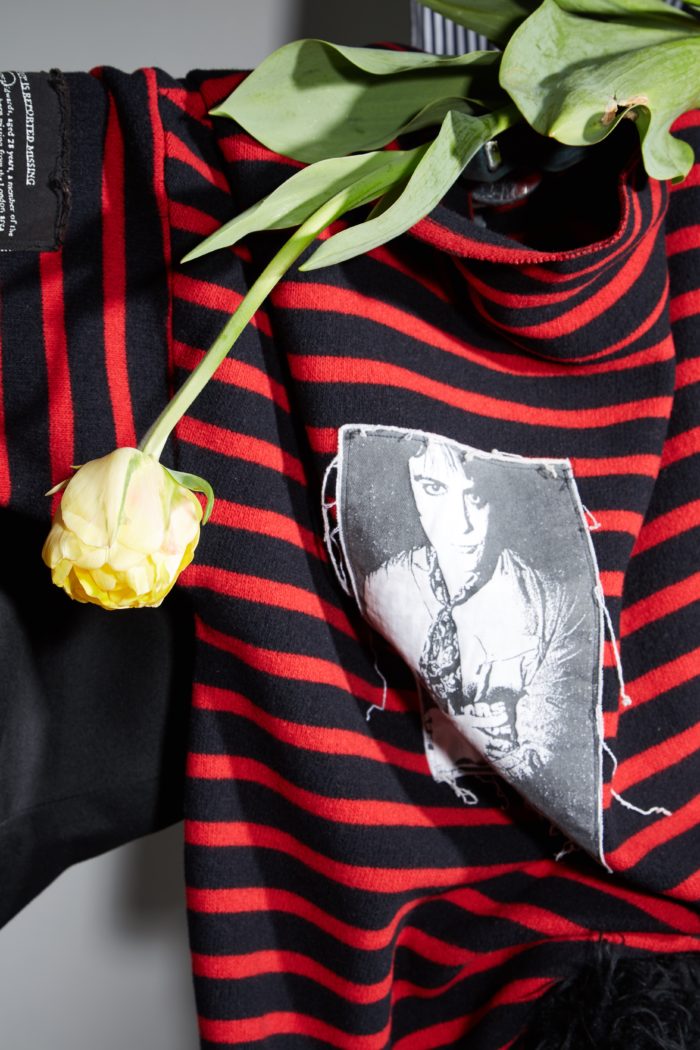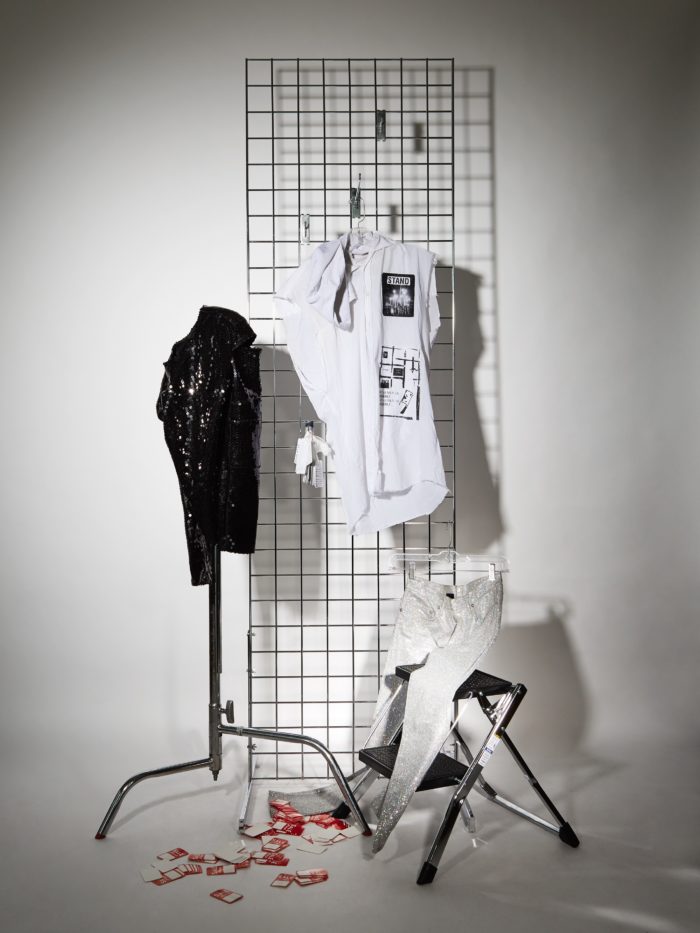
The first time I met David Casavant, I thought he was lost. I was running around Spring Studios on the set of Cultured’s first 30 Under 35 cover shoot. He was there to dress two artists, Jacolby Satterwhite and Stewart Uoo, which I remembered only after a gruff hello. “I’m David and I’ll be done in a flash,” he said. And without much fuss he was, gliding out as easily as he’d come, leaving the world behind him a little more luxurious (and impeccably dressed in head-to-toe Helmut Lang).
Hassled for a job description, Casavant calls himself a stylist, but the truth is he’s more of a collector. In a sky-high apartment, which stares down at New York from the 75th floor, is a one-of-a-kind cabinet of curiosities filled with shelves of Raf Simons, Helmut Lang, Stephen Sprouse and Craig Green—to name a few. Now known in its sum as the David Casavant Archive, this library of men’s garments and accessories serves as a resource for a new generation of artists and designers.
“Everyone always asks what piece I bought first, but the truth is that I don’t remember,” the 27-year-old says, walking into a room reserved for Lang’s first menswear collections. “When I started I had no idea what any of this would mean or become. I think that is part of my collection’s magic, the organic nature of its life outside of my own.”

This theme of escapism through objects can be traced back to when Casavant, as a 14-year-old on a mountain in Tennessee, started hoarding men’s ready-to-wear, which he purchased on the cheap from a primordial eBay. “It was a compulsion, a need that was necessarily tied to wearing it,” Casavant says. “Everything I knew about style and culture came through the internet. I was looking to participate in some way and at the time, no one was as interested in menswear as I was.”
Buying the last season’s cast-offs, Casavant amassed his monster. “Since I was young I had the mentality of never getting rid of anything,” he says. “The way I buy is I want it for the rest of my life. And in the 2000s when I really started, H&M and fast fashion brands were exploding. The mentality was ‘get rid of last season,’ which I just thought was so stupid at the time. Fashion isn’t a trend, it’s an ongoing narrative.”
Casavant’s own story led him to Central Saint Martins, where he was told his ever-expanding closet suited him more as a stylist than a designer. “I got really into the idea of translating things through imagery so I sort of did photography in the end,” he says of his thesis project, which was a portfolio of images capturing Casavant’s own designs mixed in with archival pieces.

After graduating, Casavant followed his stylist peers, assisting his predecessors Carine Roitfeld, Mel Ottenberg and Katie Grand. “I was the one who, when they needed that last-minute perfect black turtleneck, would have it,” he says. “Eventually, it was a service I was able to charge for.”
When I ask Casavant about his tipping point, he laughs. “I remember saying, ‘I know this is ridiculous putting all this money into clothes, but I just need Kanye to come over and it will be great,’” he says. “And then he did.” Rihanna followed shortly thereafter.
“I always knew male rappers and artists would have an appreciation for these clothes one day, but what I didn’t expect was that these clothes would resonate even more with women,” Casavant says of his current clientele. “It makes sense because it’s ridiculous how they make women’s clothes. Pants with no pockets is so stupid. Of course they’re just going to wear men’s pants.”

Today, Casavant lends to fashion houses, magazines and a select group of celebrities, but the archive isn’t open to everyone. “I only loan for things I believe in, because if someone wears it on stage and it rips I don’t want to have to feel bad,” he says. “It has to be someone cool enough that if it gets stained or torn, that becomes a part of the story and makes it even richer.”
Alongside his usual creative consulting for brands like Yeezy, Casavant pursues projects with friends like Satterwhite, with whom he’s worked with on projects for SFMOMA and the Whitney Museum. “We would always play dress up with the archive and go out, creating different characters through the clothes,” Satterwhite says of their first experiments. “Of course, I was shameless enough to wear anything.”
Eventually this act was crystallized and swallowed into Satterwhite’s methodology. “David knows the history of clothing that I’d always wanted to tap into through my performances,” says the artist. “His knowledge base is almost scientific. He understands how consumerism and culture touched each other and manifested through style, which is something I’ve always explored in my own work.”

Their latest project, which unfolded at Gavin Brown’s enterprise on the Lower East Side, was a boutique inspired by Satterwhite’s mother, Patricia, who used to draw products for her own version of QVC. Casavant’s version includes the usual suspects—pencils, totes and mugs—as well as a short run of Satterwhite look-alike dolls with a full Barbie-like wardrobe. “Someone bought the installation, so I’m going to have to produce more,” Casavant says with a smile as he tugs leather pants onto one of his prototypes.
Casavant sees projects like this as a way to keep the clothes alive, similar to the way the musical instruments in the Metropolitan Museum of Art require regular play. His latest project, a book with Damiani launching this fall, will encapsulate this philosophy through its open-ended interpretation of his collection. Casavant asked friends like Maggie Lee, Raúl de Nieves and even Kanye West to create images of their choice using whatever they like from the collection. The garments used in each shoot will be indexed at the back like a catalog, but no text will interfere with the running imagery—revealing Casavant’s own approach to community building. “There are fewer platforms for young, creative people, and I speak firsthand knowing that,” Casavant says. “We have to make our own spaces. It’s about saying, I’m going to make my own stage for people I admire, a stage where they could step outside whatever their world is—the fashion magazine world or the art museum. In those spaces, they have to bow down, sacrifice a little freedom, but this book isn’t that. It’s just for fun.”
If you ask Casavant’s friends, they have another take. “I think what David is doing for artists is critical,” Satterwhite says. “It’s a new way to understand one’s possessions. He’s a kind of activist or revivalist. He gives clothing a new life and a chance to tell the stories of their creation. He’s the antidote to what we see now, where value is tied up in waste.”
I watched this firsthand as artists Andy Harman and Vincent Dilio began shopping through the archive for our shoot and Casavant hung back. “I know this closet inside and out,” he says. “My biggest reward is being surprised by how other people interpret it.”




